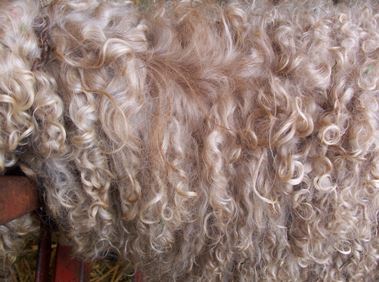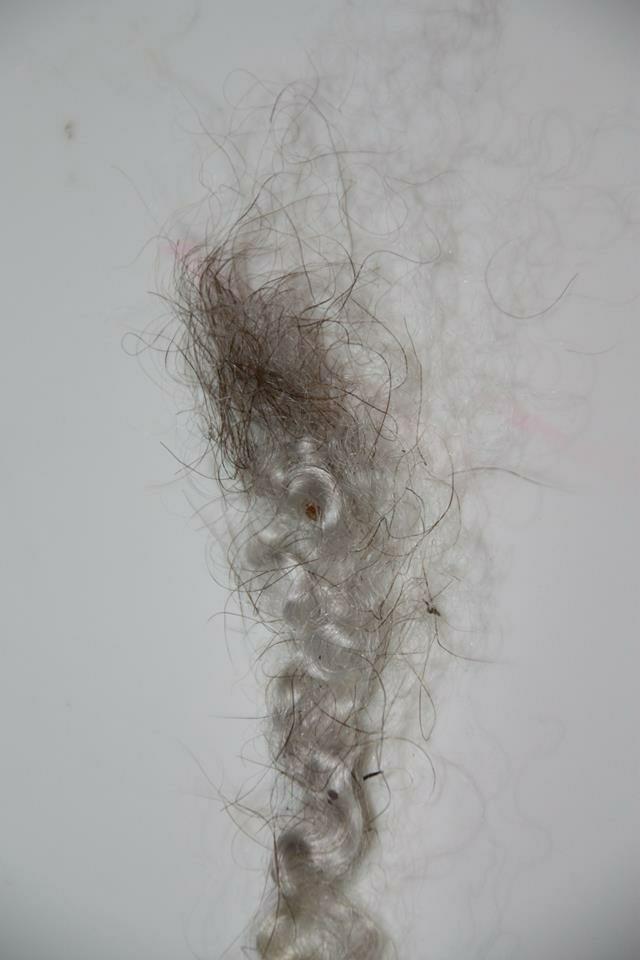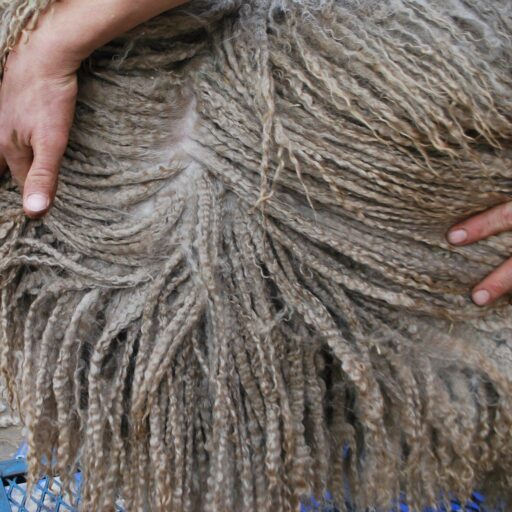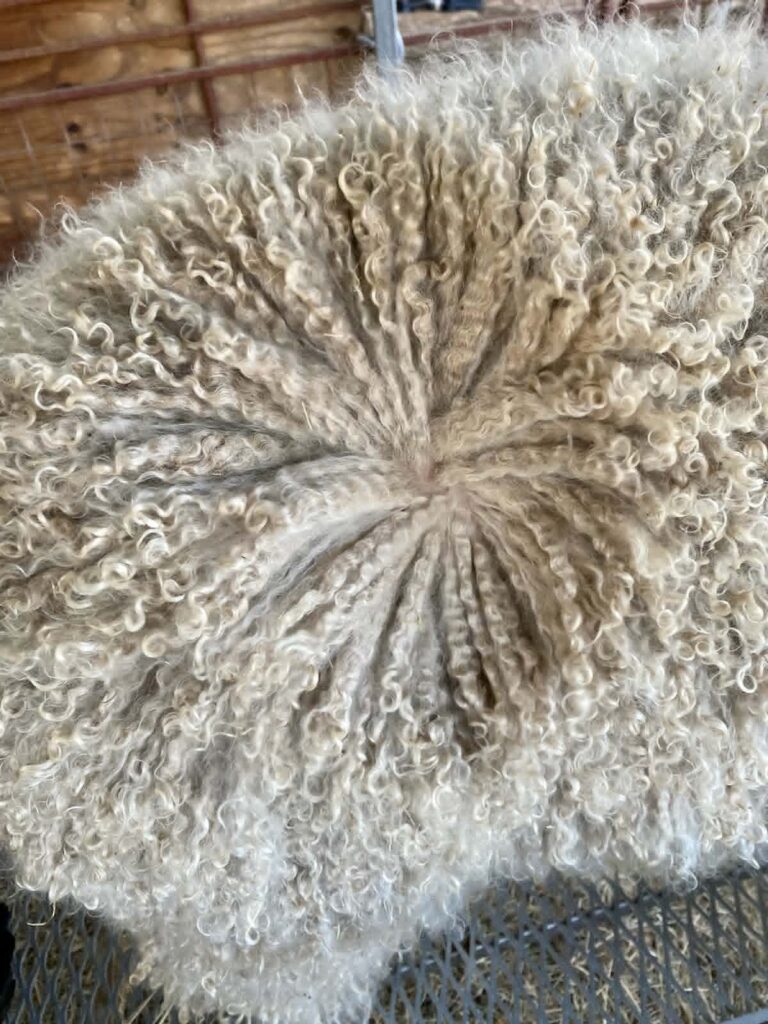
Mohair is a luxury fiber admired throughout the world. This beautiful fiber is prized for its luster, softness and strength.
A good Mohair fleece will be characterized by locks or bunches of mohair fibers held together by the curl of the fleece, with a light sheen of oil and a good long staple. Angora goats produce as much as an inch of fiber a month. Since angora goats are usually shorn twice a year, fleeces have a four to six inch staple.
The grease in a Mohair fleece helps to protect the fibers from the dust, sun and rain. Too little grease in the fleece results in a fluffy, dull looking fleece and often with poor lock formation. Too much grease gives the fleece a black look and will be difficult to wash. A light coating of grease keeps the luster in the fleece, protects it from the weather and felting and helps to hold the locks together. The grease in a goat fleece in not lanolin.
Mohair ranges from very fine and soft to coarse and scratchy. Kids produce the finest fiber and the first shearing (fall or summer clip) is the finest of all. These fleeces generally have very little oil, are very soft and are in the range of 20-24 microns. Kids start producing quality fiber by the second clip (spring clip). Progressively, as the animal ages, the Mohair can get coarser, and the average fiber diameter can increase. Because of hormones, bucks tend to get coarse faster than does, but produce considerably more fleece. Wethers (castrated males) do not coarsen as fast as bucks and produce heavier fleeces than does. Wethers are excellent fiber growers as they don't have the stress of the rut or kidding and lactation.
Kemp and Medulated fibers are undesirable. Kemp fibers are coarse, hollow and often short fibers that tend to be stiff and opaque and often deeply pigmented. Kemp fibers are very undesirable because they stick out of yarns and finished garments and are scratchy. (See Dark Brown Kemp fibers in the photo Right.) Medulated fibers are slightly coarser than true mohair fibers and have an interrupted or partially hollow core. (See Darker Red/Brown Medulated fibers in the photo Left) Often they are as long as true mohair fibers. Medulated fibers are also undesirable although not as big a problem as Kemp fibers.
Mohair and wool share several growth characteristics that set them apart from the typical hair growth patterns of other animals. Mohair is similar to most animal hair coats in that it is comprised of two types of fibers. A coarse outer coat of fiber produced by primary follicles and a fine undercoat grown by secondary follicles. In most animal coats, the primary follicles produce guard hairs that shed rain and protect the undercoat of fine downy fibers that insulate the animal.
Angora goats and many sheep breeds are unusual in that the production of fibers by the secondary follicles overtakes the primary follicle production making these fibers rare in the fleece. In angora goats it is the secondary follicles that produce most of the true mohair fibers, although in highly bred goats some primary follicles also produce true mohair fibers.
The difference between fibers produced by primary and secondary follicles lies in their structure. All fibers are formed with an outer layer of cells called the cuticle and an inner core of cells called the cortex. The fibers produced by many primary follicles of the angora goat and most animals also contain a hollow core of dead air filled cells. This medulla traps air and adds to the insulating ability of the fiber and to its opaque appearance.
Over 65% of the volume of a Kemp fiber is airspace, which reduces the fiber elasticity, strength and ability to take up dye. Medulated fibers also have a hollow core, but are less than 65% airspace by volume and are not considered to be much of a problem in processing Mohair. True mohair fiber have no medulla and this results in its translucent appearance.
The problem is that without a microscope it is hard to say which fibers are Kemp and which are Medulated. The bottom line is these fibers are coarser than mohair fibers. How much coarser depends on the breeding of the goat and the size of the medulla (the really big ones being Kemp). The length of these fibers also depends on the breeding of the goat and how fine or coarse those Medulated fibers are. Really short fibers tend to poke out of the locks and form a fuzz or halo of fibers between the locks. These fibers will not process with the mohair nor will fibers that are significantly coarser.
Mohair Washing Instructions
Washing mohair is easy. It can be washed in mesh bags which reduces the handling of the fiber and helps the locks stay intact. However, the bags do make it harder to get the fleece clean. The more water that can get around the fiber, the easier it is to clean. It is best to wash only 4-5 pounds of fiber at one time. The steps below will guide you through the process with ease.
- Fill your washer or deep sink with hot water (approximately 160 degrees F.).
- Gently submerge the mohair in the water and let soak for 30 minutes. Do not agitate the fiber or you'll have felt!
- Drain the water from your washer, then using the spin cycle ONLY, spin the water from the fiber. If you're using a deep sink, lift the fiber out of the water and squeeze the excess water out. Place in a separate tub while you drain the water.
- Refill your washer/deep sink with hot water and stir in 1/4 cup detergent (e.g. Dawn) per pound of fiber, then gently submerge the mohair in the water and let soak for 30-60 minutes.
Don't let the water cool too much. If the water gets too cold, the grease in the fiber creates a thick scum that redeposits on the fiber and is difficult to remove. - Repeat steps 3 and 4 using 1/4 cup detergent, until the fiber looks clean.
- Rinse the fiber in hot water in the same manner you washed the fiber. A couple rinses may be necessary--rinse until the water is clear. You may want to put a small amount of vinegar (white) or hair conditioner in the final rinse.
- Dry the fiber on racks or screens out of the direct sun or in a warm room.
Spinning Mohair
The long staple length of mohair aids in the ease of spinning. Mohair can be combed, carded, or spun directly from teased locks.
Mohair is not difficult to spin, but does require a slightly different process than spinning wool. Mohair fibers draw much more freely than wool because they do not have the same scales that cause wool fibers to bind to each other. Mohair, therefore, can feel slippery to spin. To counter this, reduce the tension on your brake, so that there is just enough pull to wind the yarn onto the bobbin.
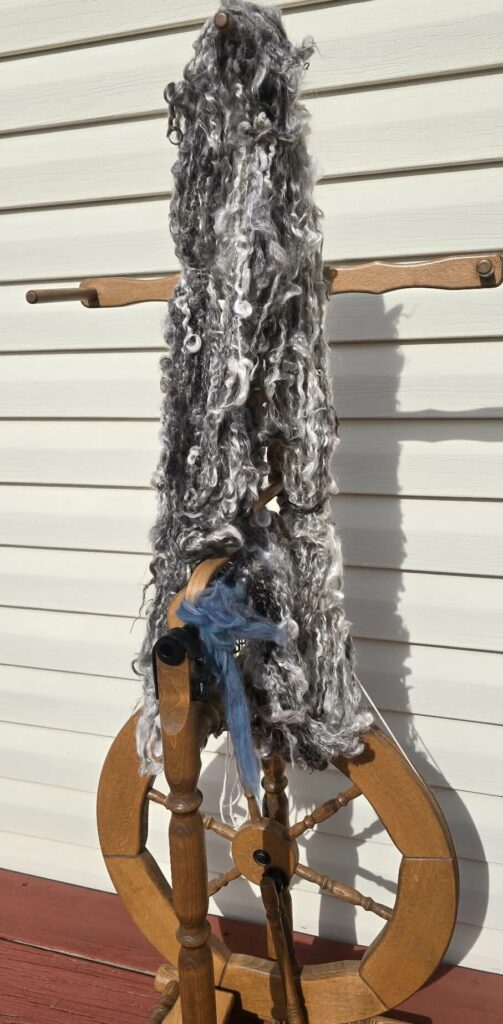
Hand Spun Natural Colored Mohair "Lock Spun"
When spinning mohair, avoid running your finger and thumb down the twist, like you would when spinning wool. Instead, open your fingers and re-grasp the fiber further down the yarn (this is "woolen-style" spinning). This will keep your yarn airy and fluffy. Ply mohair singles using the same method, with only a light or low twist, or you may end up with a tight string instead of a nice fluffy yarn. Mohair singles typically are softer and loftier than plied yarns.
Luster is a prime quality of mohair and you can enhance that natural luster by using a low twist in both worsted and woolen yarns. Low twist allows light to bounce off more fiber surfaces, producing a rich, glowing halo effect. In a high-twist, compact yarn, light can reflect off fewer surface areas, resulting in a duller effect. Therefore, to enhance luster, use only the amount of twist necessary to make a stable yarn suitable for your end product.
If a yarn will be subjected to very hard wear, durability will be more important and, therefore, more twist will be required. Worsted yarn is strong and hard wearing, whereas lofty, semi-worsted and woolen-spun yarns are light in weight and ideal for articles that will not be subject to hard wear.

Dyed and Natural White Mohair "Lock Spun"
Fancy or novelty yarns can be spun of mohair or mohair can be used for “core spinning”, Bouclé and other novelty yarns are particularly popular and perfectly suited for mohair. Try plying mohair with another type of fiber. For example, when washed, a ply of wool will shrink, but the mohair will not, resulting in more frizz and curl in the finished yarn. Also try brushing the yarn or the finished garment to enhance the lustrous “halo” produced by mohair. Use a natural bristle brush, like one used for human hair. Finally, wash and block your yarn before you make your finished product. It will help balance any inconsistencies in the yarn, making knitting and weaving easier.
Mohair is a silky, lustrous, versatile, and durable fiber, which doesn't wrinkle easily, making it great for traveling. Depending on the grade of mohair, it can be used for a wide variety of items from baby apparel to saddle blankets, and all finished products in between, including coats, suits, dresses, sweaters, hats, scarves, shawls, mittens, loungewear, socks, doll hair and beards, blankets, upholstery, draperies, carpets, and rugs. Mohair is used in knitting, crocheting, weaving, felting, and a wide variety of other fiber arts.
MOHAIR – THE AFFORDABLE LUXURY FIBER
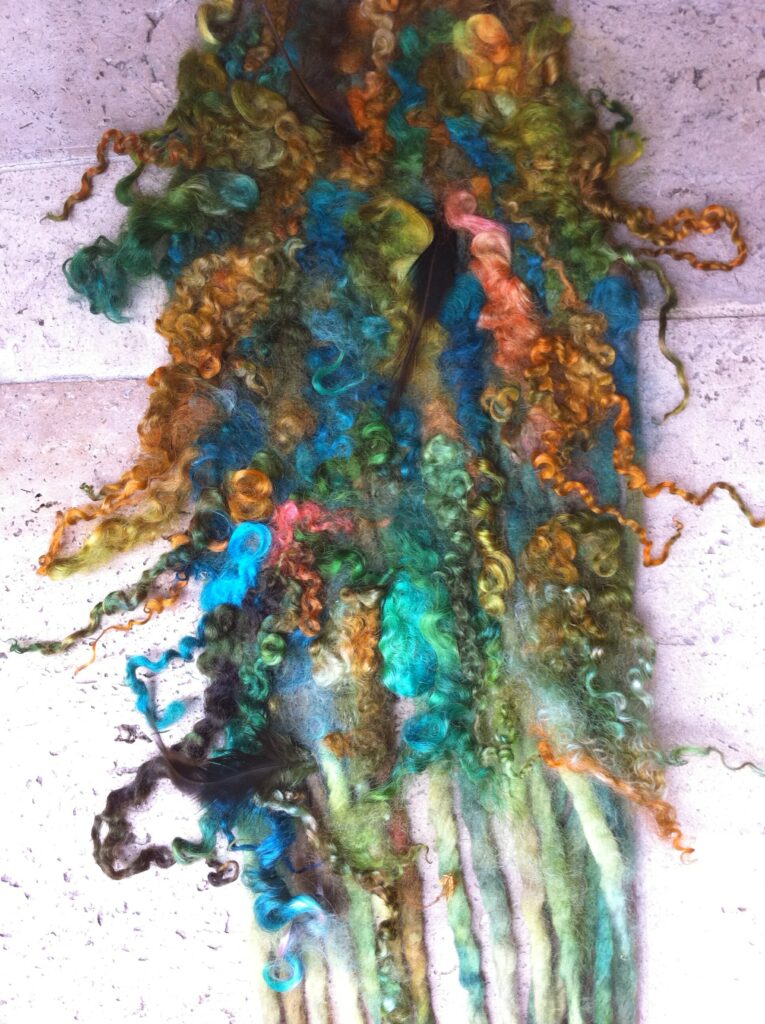
Dyed Mohair Hand Spun Art Yarn
